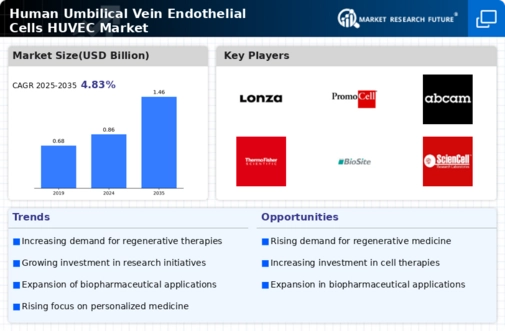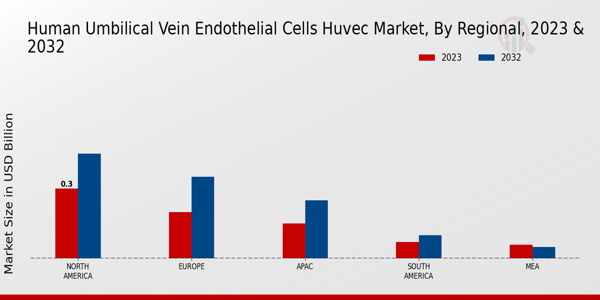Market Growth Projections
The Global Human Umbilical Vein Endothelial Cells HUVEC Market Industry is projected to experience substantial growth, with estimates indicating a rise from 0.86 USD Billion in 2024 to 1.46 USD Billion by 2035. This growth trajectory suggests a compound annual growth rate of 4.91% from 2025 to 2035. The increasing applications of HUVECs in various fields, including regenerative medicine and drug development, are likely to fuel this expansion. As research continues to unveil the potential of HUVECs, the market is expected to attract further investments and innovations, solidifying its position in the biomedical landscape.
Advancements in Cell Culture Techniques
Advancements in cell culture techniques are propelling the Global Human Umbilical Vein Endothelial Cells HUVEC Market Industry forward. Improved methodologies enhance the viability and functionality of HUVECs, making them more suitable for research and therapeutic applications. Techniques such as 3D culture systems and bioreactor technologies are being increasingly adopted, allowing for better mimicry of in vivo conditions. This innovation not only boosts research outcomes but also supports the development of personalized medicine approaches. As these techniques evolve, they are expected to contribute to the market's growth trajectory, potentially reaching 1.46 USD Billion by 2035.
Emerging Trends in Personalized Medicine
Emerging trends in personalized medicine are influencing the Global Human Umbilical Vein Endothelial Cells HUVEC Market Industry. As healthcare shifts towards tailored treatments, HUVECs are becoming essential for developing patient-specific therapies. Their unique properties allow researchers to create models that closely resemble individual patient conditions, facilitating more effective treatment strategies. This trend aligns with the broader movement towards precision medicine, which is gaining traction globally. The increasing focus on personalized approaches is expected to drive demand for HUVECs, contributing to the market's growth and innovation in therapeutic applications.
Growing Applications in Drug Development
The Global Human Umbilical Vein Endothelial Cells HUVEC Market Industry is experiencing growth due to the expanding applications of HUVECs in drug development. Pharmaceutical companies are increasingly utilizing HUVECs for in vitro testing of drug efficacy and safety, particularly in the context of vascular-targeted therapies. This trend is supported by regulatory bodies advocating for more predictive models in drug testing. As the pharmaceutical landscape evolves, the reliance on HUVECs is expected to rise, further driving market growth. The integration of HUVECs into drug development processes is likely to enhance the efficiency and accuracy of therapeutic evaluations.
Rising Investment in Biomedical Research
The Global Human Umbilical Vein Endothelial Cells HUVEC Market Industry benefits from rising investments in biomedical research. Governments and private entities are increasingly funding research initiatives aimed at understanding vascular biology and developing new therapies. This influx of capital facilitates the exploration of HUVEC applications in drug testing and disease modeling. As research institutions expand their capabilities, the demand for HUVECs is likely to increase. The anticipated compound annual growth rate of 4.91% from 2025 to 2035 underscores the potential for sustained growth in this sector, driven by ongoing research and development efforts.
Increasing Demand for Regenerative Medicine
The Global Human Umbilical Vein Endothelial Cells HUVEC Market Industry is witnessing a surge in demand driven by the growing interest in regenerative medicine. HUVECs are pivotal in developing therapies for various conditions, including cardiovascular diseases and tissue engineering. As the global population ages, the need for innovative treatment options escalates. The market is projected to reach 0.86 USD Billion in 2024, reflecting a robust interest in cellular therapies. This trend is likely to continue, with the market expected to grow significantly as research advances and clinical applications expand.

























Leave a Comment